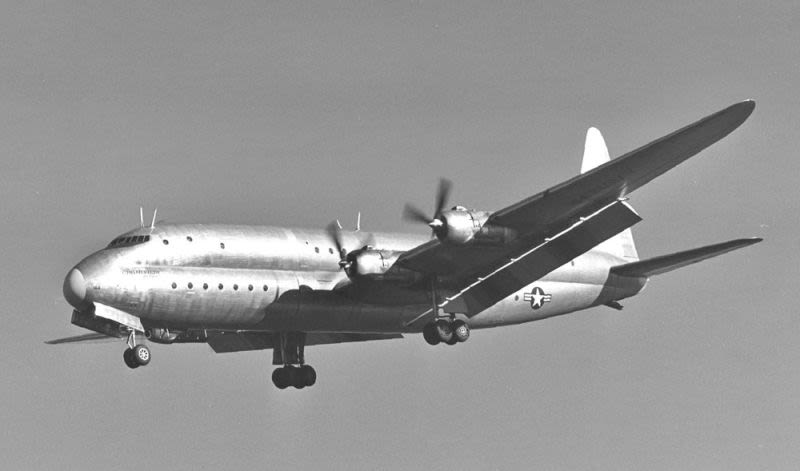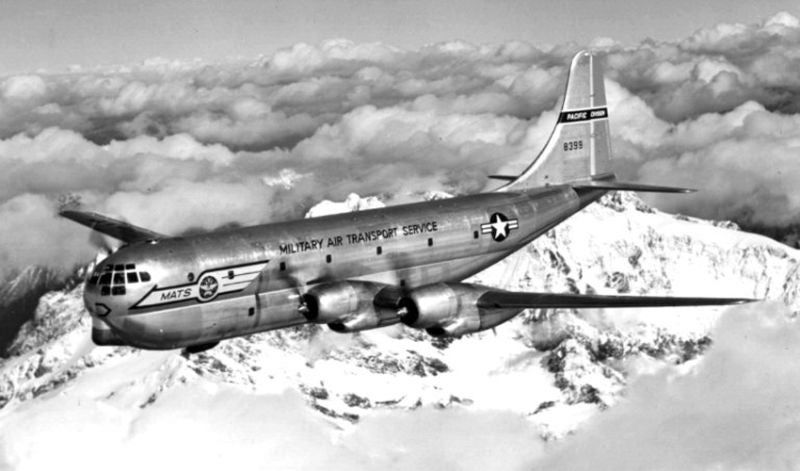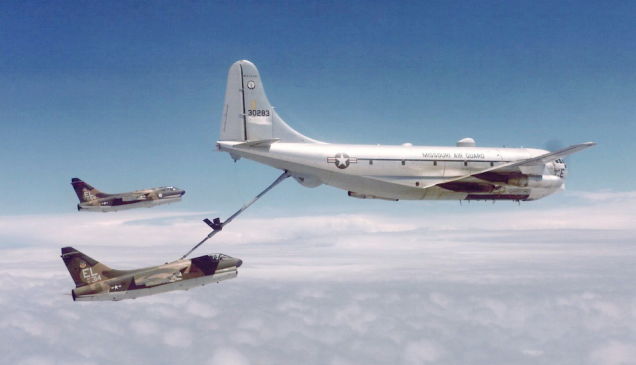 "ttyymmnn" (ttyymmnn)
"ttyymmnn" (ttyymmnn)
11/09/2018 at 12:35 • Filed to: wingspan, Planelopnik, TDIAH
 7
7
 16
16
 "ttyymmnn" (ttyymmnn)
"ttyymmnn" (ttyymmnn)
11/09/2018 at 12:35 • Filed to: wingspan, Planelopnik, TDIAH |  7 7
|  16 16 |
!!! UNKNOWN CONTENT TYPE !!!
Welcome to
This Date in Aviation History
, getting of you caught up on milestones, important historical events and people in aviation from November 7 through November 9.
!!! UNKNOWN CONTENT TYPE !!!
 !!!CAPTION ERROR: MAY BE MULTI-LINE OR CONTAIN LINK!!!
!!!CAPTION ERROR: MAY BE MULTI-LINE OR CONTAIN LINK!!!
November 9, 1946 – The first flight of the Lockheed Constitution. Throughout aviation history, there have been numerous !!!error: Indecipherable SUB-paragraph formatting!!! . Some were just very large aircraft with two decks, but others were so-called “double bubble” aircraft. Since a pressurized aircraft is essentially an aluminum tube, a double bubble aircraft stacks one tube atop another to create more space for passengers or cargo. While some aircraft were modified as double-deckers from existing aircraft, the Lockheed Constitution was designed from the ground up to be a double bubble double-decker.
Development of the R6V began in 1942 with a joint study by the US Navy, Pan Am, and Lockheed to develop a large transport aircraft to supplement the Navy’s aging fleet of flying boats. Pan Am signed to the project on in the hopes that any aircraft coming out of the partnership might also have commercial applications. Design specifications stated that the fully pressurized aircraft must be capable of carrying 17,500 pounds of payload at an altitude of 25,000 feet for 5,000 miles. When it was completed, the Constitution was the largest fixed wing aircraft ever flown by the US Navy, but only two were ever built.

Constitution No. 1 arriving at NAS Jacksonville, Florida, 1949 (Lockheed)
Ship No. 1 was completed in 1946 and took its maiden flight on November 9 of that year. Flight testing showed the engines to be significantly underpowered, so they were replaced by more powerful
!!!error: Indecipherable SUB-paragraph formatting!!!
engines with
!!!error: Indecipherable SUB-paragraph formatting!!!
that offered 3,500 horsepower each. Rockets could also be mounted under the wings to assist in takeoffs with heavier payloads. Ship No. 2 took its maiden flight on June 9, 1948 and had an upper deck sumptuously fitted out for 92 passengers and 12 crew. The lower deck was fitted for cargo, but could also be configured to carry 76 passengers in addition to those on the upper deck. On February 3, 1949, Ship No. 2 flew 74 members of the press from Moffett Field in California to Washington National Airport, setting a record for the most passengers transported on a nonstop transcontinental flight.

Lockheed RV6 Constitution performing a rocket-assisted takeoff (Author unknown)
In the end, though, the Constitution couldn’t live up to its billing. It remained underpowered, even with its engine upgrade, and problems with engine overheating led to a reduced operational range. In 1949, the Navy decided that the aircraft were just too expensive to operate and offered to lease them to the airlines. But there were no takers. Both aircraft were eventually sold for $97,785 in a deal that included 13 engines, which was quite bargain considering that the contract to build the two aircraft cost the US government $27 million. After the sale, both Constitutions suffered ignominious fates. Ship No. 1 was taken to Las Vegas where it was used as a
!!!error: Indecipherable SUB-paragraph formatting!!!
for Alamo Airways. It ended up being scrapped by Howard Hughes when he bought the property. Ship No. 2 was taken to Opa-Locka Airport in Florida and stored at an airfield. It was eventually moved off the airport to a
!!!error: Indecipherable SUB-paragraph formatting!!!
, and there were plans to use it as a restaurant and museum. But those plans fell through, and the aircraft was finally scrapped in 1978.
!!! UNKNOWN CONTENT TYPE !!!

(US Air Force)
November 9, 1944 – The first flight of the Boeing C-97 Stratofreighter. It is probably safe to say that the !!!error: Indecipherable SUB-paragraph formatting!!! was one of the greatest airplanes to come out of WWII. Not only was the B-29 an exceptional bomber, it proved to be such a versatile aircraft that its descendants continued serving long after the war was over, and they did so in many different guises. After its initial use as a long-range bomber, the B-29 was pressed into service as the !!!error: Indecipherable SUB-paragraph formatting!!! aerial tanker, which helped the US Air Force develop procedures for reliably refueling aircraft in the air. Later, the B-29 was developed into the !!!error: Indecipherable SUB-paragraph formatting!!! , the last piston-engined bomber produced for the US Air Force, as well as the KB-50 aerial tanker variant. Both were eventually replaced by newer jet-powered designs, but a more radical descendant of the venerable B-29 served for more than 30 years, and served into the 1970s.
 !!!CAPTION ERROR: MAY BE MULTI-LINE OR CONTAIN LINK!!!
!!!CAPTION ERROR: MAY BE MULTI-LINE OR CONTAIN LINK!!!
The B-29 was originally designed with the single purpose of carrying a large load of bombs a great distance. But with the end of WWII, what the Air Force really needed was an aircraft that could carry tons of cargo or large numbers of passengers or troops. Starting with the proven B-29 Superfortress, Boeing retained the engines, wings, tail, and half the fuselage, but then added a second, larger tube on top, giving the C-97 a double bubble structure that significantly increased its cargo-carrying capacity. After the construction of the first 10 Stratofreighters, the engines were upgraded to the same 3,500 horsepower !!!error: Indecipherable SUB-paragraph formatting!!! engines used on the B-50. The taller vertical stabilizer was also borrowed from the B-50 to compensate for the larger fuselage. Clamshell doors opened under the tail for loading, and a ramp allowed vehicles or other equipment to be driven directly into the cargo hold. However, these doors could not be opened in flight, so the C-97 was not capable of performing parachute drops of troops.

A Boeing KC-97L Stratofreighter of the Missouri Air National Guard refuels two US Air Force Vought A-7D Corsair IIs of the 23rd Tactical Fighter Wing (US Air Force)
The C-97 was introduced in 1947, and one C-97 took part in the
!!!error: Indecipherable SUB-paragraph formatting!!!
, but a landing accident grounded it until after the crisis ended. The Stratofreighter went on to serve in both the Korean War and the Vietnam War, and was also converted into an early airborne command post for the
!!!error: Indecipherable SUB-paragraph formatting!!!
. And, like its B-29 predecessor, the C-97 was developed into the
!!!error: Indecipherable SUB-paragraph formatting!!!
aerial tanker, and the later the KC-97L was made faster by the addition of a
!!!error: Indecipherable SUB-paragraph formatting!!!
turbojet engine under each wing to help it keep pace with faster jet fighters. Later, in yet further testament to Boeing’s flexible design, the C-97 was developed into the
!!!error: Indecipherable SUB-paragraph formatting!!!
, a double-decker, pressurized airliner that could accommodate up to 114 passengers on its two decks. But even that wasn’t the end of the lineage that started with the B-29, as the 377 was also developed into the
!!!error: Indecipherable SUB-paragraph formatting!!!
series of super-size cargo aircraft. A total of 888 C-97s were built, with the bulk of them serving in the aerial refueling role. After finishing its service with the National Guard, the C-97 was finally retired in 1978.
!!! UNKNOWN CONTENT TYPE !!!
!!! UNKNOWN CONTENT TYPE !!!
Short Takeoff
!!! UNKNOWN CONTENT TYPE !!!
 !!!CAPTION ERROR: MAY BE MULTI-LINE OR CONTAIN LINK!!!
!!!CAPTION ERROR: MAY BE MULTI-LINE OR CONTAIN LINK!!!
November 7, 2001 – The Concorde resumes passenger flights. On July 25, 2000, !!!error: Indecipherable SUB-paragraph formatting!!! (F-BTSC) crashed shortly after takeoff from Paris-Charles de Gaulle Airport. The official cause of the crash was cited as debris on the runway that damaged a tire and lead to a fuel leak and catastrophic fire. Though it was the only crash in the history of Concorde operations, all Concordes were grounded during the investigation, and remaining aircraft were updated with Kevlar-lined fuel tanks and burst-resistant tires before retuning to service. Despite its return to passenger service, the Concorde could not overcome a downturn in air travel following the Flight 4590 crash and the !!!error: Indecipherable SUB-paragraph formatting!!! . High maintenance and fuel costs added to the Concorde’s woes, and all Concordes were retired in 2003.
!!! UNKNOWN CONTENT TYPE !!!

Australia Government)
November 8, 1935 – The death of Charles Kingsford Smith. Kingsford Smith, known by his nickname “Smithy,” served as a motorcycle dispatch rider during the !!!error: Indecipherable SUB-paragraph formatting!!! in WWI before joining the !!!error: Indecipherable SUB-paragraph formatting!!! in 1917. Following the war, he worked as a !!!error: Indecipherable SUB-paragraph formatting!!! in the US and flew airmail in Australia, and initially became famous for completing the first crossing of the Pacific Ocean in 1928, flying from California to Australia with !!!error: Indecipherable SUB-paragraph formatting!!! in a !!!error: Indecipherable SUB-paragraph formatting!!! named !!!error: Indecipherable SUB-paragraph formatting!!! . Kingsford Smith followed that with the first flight across Australia and the first flight across the !!!error: Indecipherable SUB-paragraph formatting!!! from Australia to New Zealand in 1928, and a westward crossing of the Atlantic Ocean from Ireland to Newfoundland in 1930. He also made the first eastward crossing of the Pacific in 1934 in a !!!error: Indecipherable SUB-paragraph formatting!!! named !!!error: Indecipherable SUB-paragraph formatting!!! . During an attempt to break the record for flying from England to Australia, Kingsford Smith and co-pilot John Pethybridge, flying the Lady Southern Cross , disappeared over the !!!error: Indecipherable SUB-paragraph formatting!!! near Burma, and their bodies were never found.
!!! UNKNOWN CONTENT TYPE !!!

(San Diego Air and Space Museum)
November 9, 1979 – The death of Louise Thaden, a pioneering aviatrix and the first woman to win the prestigious coast-to-coast Bendix Trophy Race. Thaden (née McPhetridge) was born on November 12, 1905 in Bentonville, Arkansas and entered the world of flying as a sales representative for the Travel Air Corporation owned by !!!error: Indecipherable SUB-paragraph formatting!!! . As part of her pay, she received free flying lessons, and became the first woman to earn a pilot license in Ohio and later the fourth woman to earn a rating as a transport pilot. Thaden shocked the world when she and her copilot Blanche Noyes won the !!!error: Indecipherable SUB-paragraph formatting!!! transcontinental race, setting a new world record time of 14 hours 55 minutes while flying a !!!error: Indecipherable SUB-paragraph formatting!!! . But that wasn’t the first of Thaden’s accomplishments. She set a altitude record of 20,260 feet for woman pilots in 1928, an endurance record of over 22 hours in 1929, teamed up with another aviatrix, Frances Marsalis, to set a record time of 196 hours in the air, and was a founding member of the !!!error: Indecipherable SUB-paragraph formatting!!! organization for woman pilots. Though she retired from racing in 1938 and world for the Bureau of Air Commerce, and flew with the Civil Air Patrol during WWII. Thaden died in 1979.
!!! UNKNOWN CONTENT TYPE !!!

(NASA)
November 9, 1967 – The launch of Apollo 4, the first launch after the !!!error: Indecipherable SUB-paragraph formatting!!! disaster that killed three astronauts. Apollo 4 was the critical first “all up” test for NASA, which meant that all the rocket stages and the spacecraft were operational at launch, though the flight was unmanned. Apollo 4 was also the first launch of the !!!error: Indecipherable SUB-paragraph formatting!!! launch vehicle, the tallest, heaviest and most powerful rocket ever used operationally. Apollo 4 was launched from the !!!error: Indecipherable SUB-paragraph formatting!!! !!!error: Indecipherable SUB-paragraph formatting!!! , which had been specifically built for the huge Saturn V, and was the first mission to test all elements of the multi-stage rocket. The flight lasted nine hours before splashing down in the Pacific Ocean.
!!! UNKNOWN CONTENT TYPE !!!
!!! UNKNOWN CONTENT TYPE !!!
Connecting Flights
!!! UNKNOWN CONTENT TYPE !!!
!!! UNKNOWN CONTENT TYPE !!!
!!! UNKNOWN CONTENT TYPE !!!
!!! UNKNOWN CONTENT TYPE !!!
!!! UNKNOWN CONTENT TYPE !!!
If you enjoy these Aviation History posts, please let me know in the comments. And if you missed any of the past articles, you can find them all at
!!!error: Indecipherable SUB-paragraph formatting!!!
. You can also find more stories about aviation, aviators and airplane oddities at
!!!error: Indecipherable SUB-paragraph formatting!!!
.
 user314
> ttyymmnn
user314
> ttyymmnn
11/09/2018 at 12:47 |
|

The A-7, while an excellent strike fighter, is by no means a rocket ship like it s F-8 cousin. For a SLUF to have to be flying high-alpha just to slow down enough to tank shows how slooooooow a KC-97 is.
 Chariotoflove
> ttyymmnn
Chariotoflove
> ttyymmnn
11/09/2018 at 13:01 |
|
It’s kind of amazing how many times you hear the initial version of an aircraft had underpowered engines that needed to be upgraded. You’d think engineers would have a handle on that ahead of time. It’s like they were all Mazda engineers or something.
 KingT- 60% of the time, it works every time
> ttyymmnn
KingT- 60% of the time, it works every time
> ttyymmnn
11/09/2018 at 13:02 |
|
Speaking of Apollo 1, 4 etc. Did any Oppos watch First Man?
I did recently, thought it was really good. Very grounded, devoid of Hollywood-ism like unnecessary drama and in some scenes you actually felt you were there in the claustrophobic capsules. Great visual and sound effects.
 user314
> Chariotoflove
user314
> Chariotoflove
11/09/2018 at 13:17 |
|
There are a lot of post-WWII and early Cold War aircraft that were doomed because the engine they were designed to used either never materialized or just didn’t develop the power expected.
 thejustache
> ttyymmnn
thejustache
> ttyymmnn
11/09/2018 at 14:27 |
|
I never knew the Guppies were relatives of the B-29. Kind of makes it cooler that the Super Guppy and Doc were sharing a ramp the other day!

 ttyymmnn
> thejustache
ttyymmnn
> thejustache
11/09/2018 at 15:21 |
|
Was it you who posted about that? My comment was, “Family reunion.” If you didn’t, take a look at the article I linked to about the evolution of the B-29. It had quite a lifespan.
 ttyymmnn
> KingT- 60% of the time, it works every time
ttyymmnn
> KingT- 60% of the time, it works every time
11/09/2018 at 15:23 |
|
I have not, but I would like to.
 ttyymmnn
> Chariotoflove
ttyymmnn
> Chariotoflove
11/09/2018 at 15:25 |
|
I think it’s mostly case of aerodynamic advances outpacing advances in engine design. I have lost count of how many times I have written some version of, “The original engines were underpowered.” And, usually by the time more powerful engines came along, other advances in aircraft design rendered the original underpowered aircraft obsolete so it never entered production or was limited to few examples.
 Chariotoflove
> ttyymmnn
Chariotoflove
> ttyymmnn
11/09/2018 at 15:32 |
|
On the other hand, I seem to remember instances where upgrading the engines created the “definitive variant” that went on to have great success.
 user314
> ttyymmnn
user314
> ttyymmnn
11/09/2018 at 15:37 |
|
There’s also the “Strange Planes” episode ‘Drones, Midgets and Mutations’, which details, among other planes, the proliferation of B-29 derivations .
 ttyymmnn
> Chariotoflove
ttyymmnn
> Chariotoflove
11/09/2018 at 15:39 |
|
Indeed. My college music history teacher had a favorite saying: “All generalizations are lies.”
 user314
> thejustache
user314
> thejustache
11/09/2018 at 15:44 |
|
It’s a little more obvious when you look at a 377 or KC-97 and the original Guppy:

Aside from the wings, f inding the KC-97 DNA in a Super Guppy is challenging, let alone anything from a B-29 or B-50.
 thejustache
> ttyymmnn
thejustache
> ttyymmnn
11/09/2018 at 15:52 |
|
It wasn’t me that posted that, but I saw that post (and then saw that photo on Doc’s instagram later in the day). I read your article too, very interesting and informative. Thanks!
 gmporschenut also a fan of hondas
> Chariotoflove
gmporschenut also a fan of hondas
> Chariotoflove
11/09/2018 at 21:40 |
|
A huge challenge was estimating the aircraft weight. With 3d modeling its easy now. back then they had to add in a lot of fudge factor. A reason the dc3 is so robust and tough. recall a popular mechanics article where they discussed if the dc3 were made nowadays, it would be 30% lighter.
 Chariotoflove
> gmporschenut also a fan of hondas
Chariotoflove
> gmporschenut also a fan of hondas
11/09/2018 at 23:46 |
|
Makes sense.
 facw
> user314
facw
> user314
11/10/2018 at 05:18 |
|
We can go slower!

And I’m pretty sure this B-52 has its landing gear down for maximum drag (also note the B-52 normally flies with its nose pointing down)
